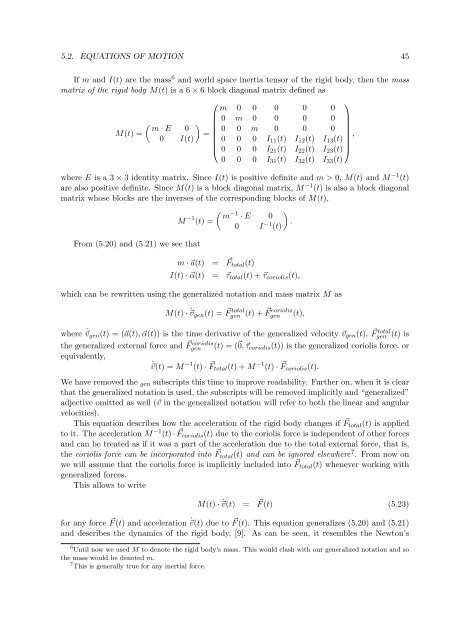thesis - Computer Graphics Group - Charles University - Univerzita ...
thesis - Computer Graphics Group - Charles University - Univerzita ...
thesis - Computer Graphics Group - Charles University - Univerzita ...
You also want an ePaper? Increase the reach of your titles
YUMPU automatically turns print PDFs into web optimized ePapers that Google loves.
5.2. EQUATIONS OF MOTION 45<br />
If m and I(t) are the mass 6 and world space inertia tensor of the rigid body, then the mass<br />
matrix of the rigid body M(t) is a 6 × 6 block diagonal matrix defined as<br />
M(t) =<br />
⎛<br />
m 0 0 0 0 0<br />
⎞<br />
<br />
m · E<br />
0<br />
⎜<br />
⎜ 0<br />
0<br />
⎜ 0<br />
= ⎜<br />
I(t) ⎜ 0<br />
⎜<br />
⎝ 0<br />
m<br />
0<br />
0<br />
0<br />
0<br />
m<br />
0<br />
0<br />
0<br />
0<br />
I11(t)<br />
I21(t)<br />
0<br />
0<br />
I12(t)<br />
I22(t)<br />
0 ⎟<br />
0<br />
⎟ ,<br />
I13(t) ⎟<br />
I23(t) ⎠<br />
0 0 0 I31(t) I32(t) I33(t)<br />
where E is a 3 × 3 identity matrix. Since I(t) is positive definite and m > 0, M(t) and M −1 (t)<br />
are also positive definite. Since M(t) is a block diagonal matrix, M −1 (t) is also a block diagonal<br />
matrix whose blocks are the inverses of the corresponding blocks of M(t),<br />
M −1 (t) =<br />
From (5.20) and (5.21) we see that<br />
<br />
m−1 · E 0<br />
0 I−1 <br />
.<br />
(t)<br />
m · a(t) = Ftotal(t)<br />
I(t) · α(t) = τtotal(t) + τcoriolis(t),<br />
which can be rewritten using the generalized notation and mass matrix M as<br />
M(t) · ˙ vgen(t) = F total<br />
gen (t) + F coriolis<br />
gen<br />
where ˙ vgen(t) = (a(t), α(t)) is the time derivative of the generalized velocity vgen(t), F total<br />
gen (t) is<br />
the generalized external force and F coriolis<br />
gen (t) = (0, τcoriolis(t)) is the generalized coriolis force, or<br />
equivalently,<br />
(t),<br />
˙v(t) = M −1 (t) · Ftotal(t) + M −1 (t) · Fcoriolis(t).<br />
We have removed the gen subscripts this time to improve readability. Further on, when it is clear<br />
that the generalized notation is used, the subscripts will be removed implicitly and “generalized”<br />
adjective omitted as well (v in the generalized notation will refer to both the linear and angular<br />
velocities).<br />
This equation describes how the acceleration of the rigid body changes if Ftotal(t) is applied<br />
to it. The acceleration M −1 (t) · Fcoriolis(t) due to the coriolis force is independent of other forces<br />
and can be treated as if it was a part of the acceleration due to the total external force, that is,<br />
the coriolis force can be incorporated into Ftotal(t) and can be ignored elsewhere 7 . From now on<br />
we will assume that the coriolis force is implicitly included into Ftotal(t) whenever working with<br />
generalized forces.<br />
This allows to write<br />
M(t) · ˙ v(t) = F (t) (5.23)<br />
for any force F (t) and acceleration ˙ v(t) due to F (t). This equation generalizes (5.20) and (5.21)<br />
and describes the dynamics of the rigid body, [9]. As can be seen, it resembles the Newton’s<br />
6 Until now we used M to denote the rigid body’s mass. This would clash with our generalized notation and so<br />
the mass would be denoted m.<br />
7 This is generally true for any inertial force.
















